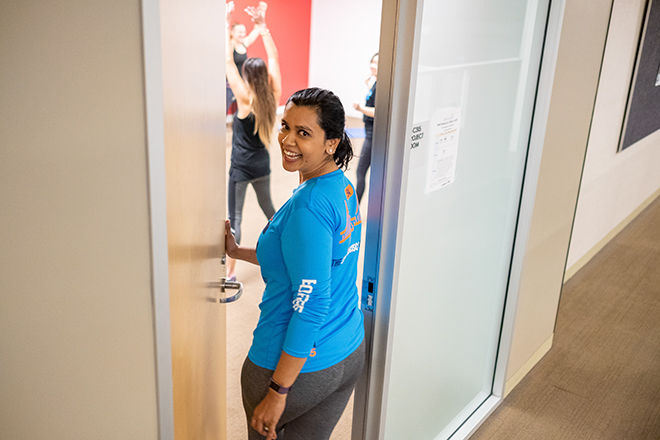How Blue Shield's digital teams are transforming the future of health care
In the highly regulated, fragmented and slow-moving healthcare industry, Blue Shield of California’s digital teams use technology to rethink and rebuild the way it works today.

Divya Devli (Digital Product Manager), Ram Krishna Gautam (Senior Manager of Digital Applications), and Chaitanya Jayaschandran and Bruce Thompson (Application Developers) explain what drew them to Blue Shield, discuss problems they’re solving, and share projects keeping them excited to come to work every day.
What do you do at Blue Shield of California?
Ram: I manage mobile apps for both Apple iOS and Android. I see my job as a combination of building and growing the Mobile team and improving the experience for our members. Blue Shield’s mission is to provide high-quality, affordable health care to all Californians, and to make that happen, we have to move health care into the digital age by using the latest technology. That’s everything from electronic ID cards, to helping people understand their benefits, to making it easier to find an urgent care provider in your network.
Day-to-day, I spend about three quarters of my time working on process improvements and planning for the future, checking in with my team to stay up to speed on their projects and see how I can help, and resolving issues we find through member feedback. The last quarter I keep free for collaboration, whether that’s with Mobile or other digital teams.
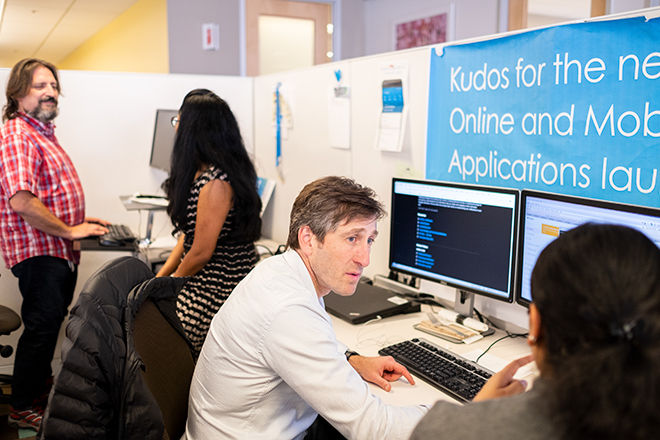
Divya: I think of our job as building the healthcare system we’d want for our family and friends. I’m a product manager on the provider side, so my goal is to help doctors improve the quality of their care by giving them useful digital tools and solutions. I collaborate with a lot of other teams — Engineering, Quality Assurance, Design, User Experience (UX), Customer Support, and Electronic Data Interchange — to troubleshoot issues and design the requirements for tools and platforms.
I’m new, both to Blue Shield and to the Product team, and right now I’m spending a lot of time learning our processes so I can see our products holistically. I get great feedback from our developers, like Bruce and Chaitanya. They’ll often have ideas or notice issues I hadn’t considered, which helps us build a simpler, more intuitive interface. I couldn’t do my job without them.
Bruce: I'm on Ram’s team, primarily working on our iOS app. I think of my job as taking the vision Divya and other colleagues come up with and making it a reality. We follow the Agile methodology, so we work in two-week sprints to groom, develop, and test products.
Chaitanya: I’m an application developer like Bruce, but on the Android side. We take the requirements from Divya and the Product team, explain them in a story using screenshots from UX, estimate what it will take to implement, and work with our technical leads and iOS teammates to develop the architecture for both platforms. Then it’s a lot of coding, testing, and creating the build.
Tell us about your background and why you joined Blue Shield.
Divya: I spent three years at Facebook after undergrad, and during that time, I was in a car accident. I received a really poor level of care, and that motivated me to get my master’s in healthcare management at Columbia. I knew this industry is often resistant to change, but when I interviewed at Blue Shield, I could tell they were focused on innovation. Everyone I met was wonderful. I immediately thought, "This isn’t just where I want to work; it’s where I want to retire."
Another big draw for me was how many female leaders we have. That’s unusual in tech, and I wanted to be in a place that relied on great women to grow.
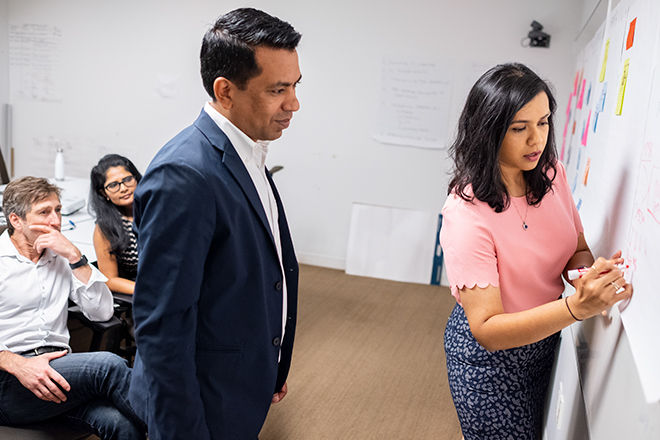
Bruce: I’ve been writing software for many years at large and small companies. I like the direction and focus at Blue Shield. We stick to our larger goals and don’t switch focus due to what the market is doing week to week. I’ve also worked in a lot of different industries, and the move to Blue Shield gave me a new perspective on health care. Being here opens your eyes to the fact that not all insurance providers are these evil companies talked about in the media.
Ram: I’ve worked as an application architect for 18 years. Before Blue Shield, I was at a national bank, and one of my customers was a healthcare company. That taught me a lot about the industry, and I saw a lot of opportunities to improve it. So one thing that excited me about joining here was the mission to make people’s lives better. I also like the opportunities to grow. I started here seven years ago as a technical lead, and I’ve received the leadership training and support I needed to become a senior manager.
Chaitanya: I’ve worked as an Android developer since 2010, but this is my first experience in health care. I originally joined Blue Shield as a contractor, and the team was one of the main reasons I decided to stay. This is a highly competent, proactive, organized group of people, and Ram is a focused, efficient manager. People appreciate you and encourage you, and that’s motivating. I’ve had a lot of opportunities to improve not only my domain knowledge and technical skills, but also my leadership qualities.
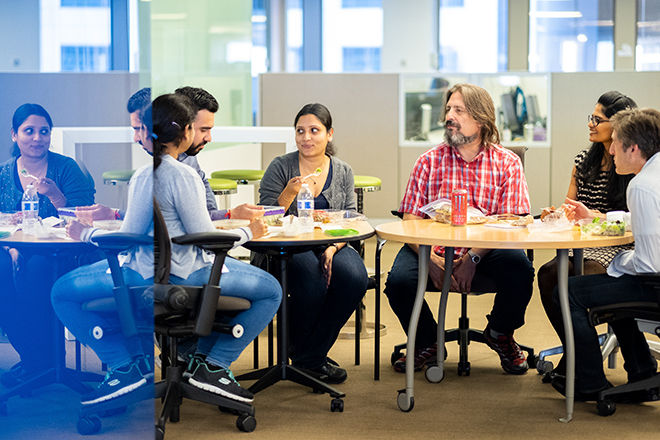
Tell us about your work on the Find a Doctor project.
Chaitanya: We want to give members the information they need quickly and accurately. So we rebuilt our Find a doctor tool this year to make it easier to use on our mobile app and website. Members can see provider ratings and reviews, network information, if they are accepting new patients, search in a map, and get directions, all in one place.
Ram: We redesigned the way the tool gets provider data, improved the data quality and added key features – like the ability to save and download search results. The impact has been significant: We've had an 18-percent decrease in negative feedback since July, and our mobile app is ranking at 4.8 stars in the iTunes App Store – higher than our competitors.
Bruce: Everyone who works on the app is also a user, which makes it easier to know how to help our members. Ram often asks us for ideas about what we’d like to see, and our feedback becomes part of the vision.
It’s a huge project. There are a lot of moving pieces, a lot of people involved, a lot of story points to consider in its execution. Streamlining multiple menus isn’t as simple as going in and changing a little code here and there. We had to redesign the entire foundation because implementing this feature on the old system would have taken far too much time to debug. And each platform was using different services before, which meant you might see different results on the web versus mobile. Now everything is uniform.
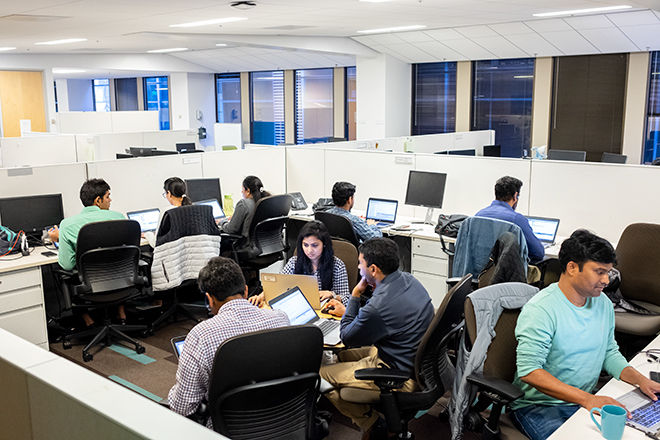
Divya: I’m excited to see how this project helps providers make referrals. I think it’s a good example of the guidance I get from my leadership: To think about our products like a consumer would. “Empathy” may not be the first word that comes to mind when you think about healthcare products, but it’s so important. This isn’t a social media tool people are using for fun — it’s addressing a real need. So we must use empathy to guide our decisions and the products we build.
What other projects are you excited about?
Ram: We’re working on making claims real-time. It will allow you to know exactly what your visit will cost, and doctors will know how much they’ll be paid.
Divya: I’m excited about making claims real-time as well, and building our strategy and roadmap for the next few years. I like that my job is a mix of day-to-day product management and contributing to our long-term vision. We do a lot of user research to figure out the best ways to integrate new products and maximize digital self-service. Blue Shield had a more project-driven approach in the past, but today it’s product-driven and very focused on digital. Because of this more outcome-focused approach, I feel I can make a real impact.
Bruce: I’m excited about a new messaging feature that we are planning to develop. It will save members save time by having us reach out to them through push notifications and email, so they can get their claim status without logging in or calling. There are a lot of other potential use cases for this as well, such as preventive care.

What technical challenges do you face?
Bruce: The iOS team is always busy in the fall when Apple releases new devices and a new iOS. We make sure our app is running properly on new screen sizes and keep things in sync and backward compatible in the updated Xcode development environment. We also adjust for anything Apple decides to drop – SVN, for example, which was the version control system we used. Now we’re moving to GIT.
Chaitanya: One broader challenge for me is I’d like to see a consistent mobile-first approach to development, both because the world is moving toward mobile and because it can be difficult to start with web and then try to shrink a page. We’re still missing that sometimes, but it’s something I’m pushing for.
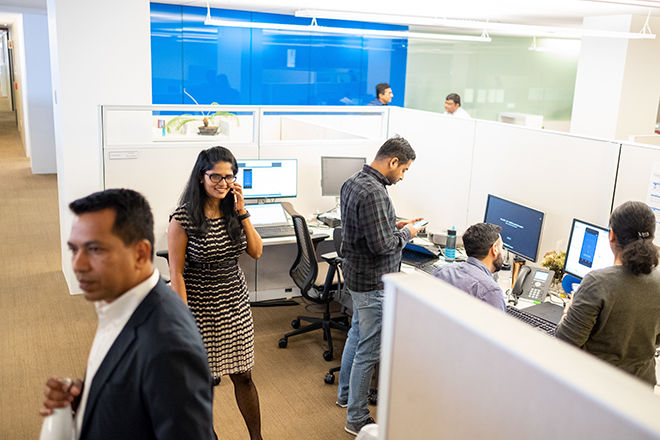
Divya: Privacy is always a challenge in health care. We have to write requirements and design tests to make sure members and providers see only the information that’s relevant to them. We’re constantly thinking about federal, state, and association mandates, which require certain notices and features. We have to integrate all this in a way that doesn’t feel forced on the user.
Ram: Working in a highly-regulated industry definitely creates challenges, but we also see that as an opportunity. When we find ways to work within those regulations and are still able to move from paper to digital records, for example, we can reduce the cost of care. That’s a huge impact.
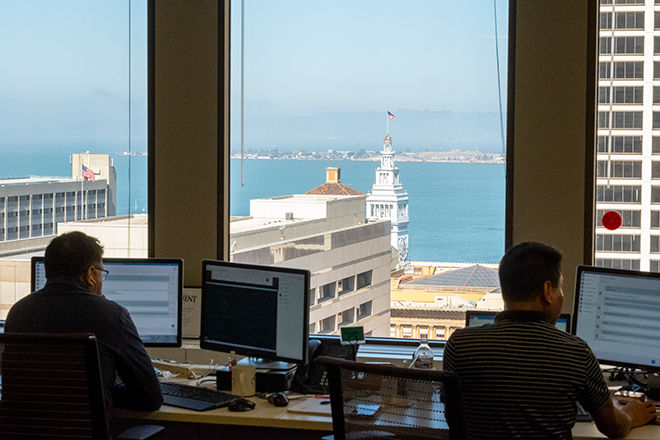
What’s mentorship like on the team?
Divya: I have weekly one-on-ones with my manager, but she told me during my first one-on-one I should also feel comfortable reaching out to anyone for mentorship, company-wide. She knows I’m interested in the work our Health Innovation Technology team is doing, for example, so she suggested I talk with them.
Chaitanya: We mentor each other, too. Bruce is my mentor for iOS development, and I mentor him on Android development. And Ram helps us plan our goals for each quarter and map out the new skills and technologies we want to learn and gives us feedback on the progress we’re making.
Ram: My manager gives me a lot of support, and I have mentors outside our team. I meet with Pooja Jmath, a senior director of digital products on Divya’s team. Pooja and I work together regularly, so it’s a good opportunity for her to give me feedback. She also helps me learn the business side, which is an interest of mine. It really all depends on what you’re interested in and how you want to grow.
Divya: And the growth is personal and professional. There’s a real focus on health; I attend several fitness classes in the office, which are part of our Wellvolution program focused on lifestyle medicine. When I come out of the elevator every morning, I see a sign that says, “Love and happiness are the only pre-existing conditions.” Those might seem like little things, but they really motivate me to be here and make a difference.
